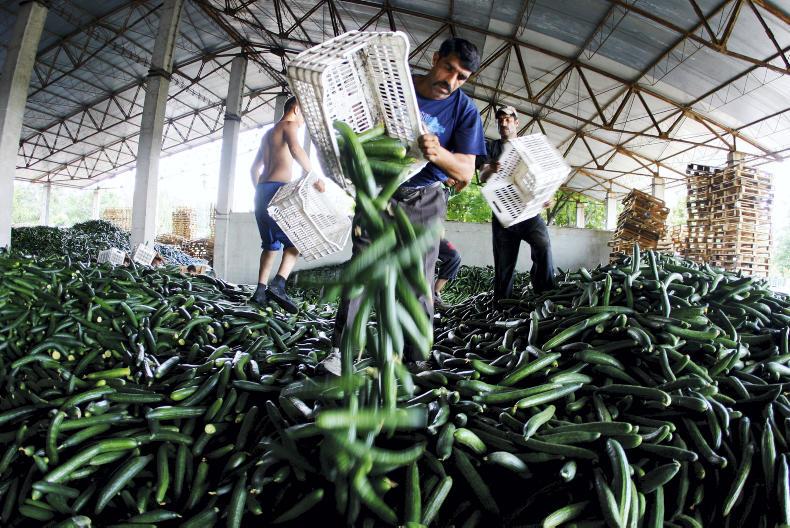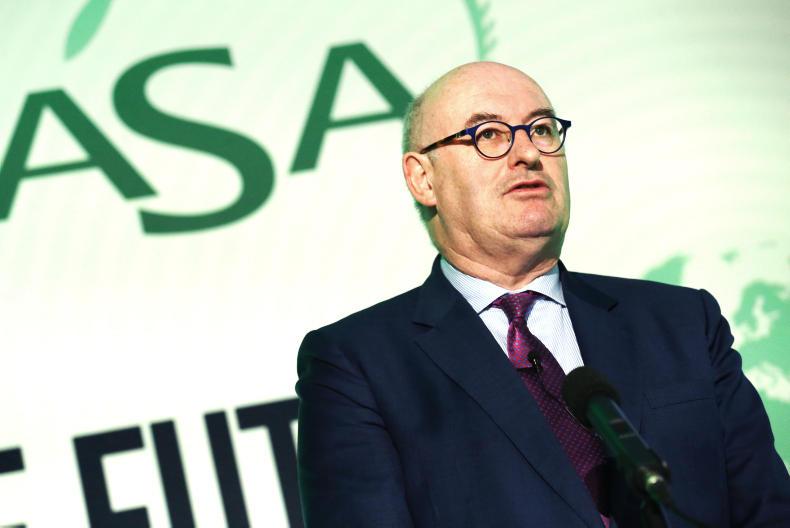The European Commission has given another glimpse of how it sees the Common Agricultural Policy (CAP) evolving post-2020 and post-Brexit.
The stated aims include an intent to support smaller farms, and those who “depend on farming for their living”, which is being taken to mean full-time farms.
These are not easy ambitions to achieve, or even to reconcile with each other.
How we define full-time farmers and active farmers has never been properly resolved. Do we quantify it in terms of the proportion of income from the farm?
Or perhaps the hours worked on the farm? Maybe the scale of activity on the farm will be the measuring stick?
These terms are all relative.
Before Irish farmers read too much into this talk, it should be remembered that terms such as “small” and “dependent on farming” vary wildly as you move around the EU.
A farmer working full-time off-farm to generate the capital to build up their holding would suffer a cut in their payments
The Commission is not just thinking of the distance between the cattle farms on the plains of Meath and the Mayo mountain sheep holdings. It must come up with a policy that encompasses the intensive Dutch farms, the former collective farms in eastern Europe, the vineyards of Italy and the Finnish farms on the edge of the Arctic Circle.
Where to start?
As things stand, the average farm in the EU is about 16ha. Taking the bigger British farms out of the equation will make the average EU farm size a little smaller.
About 4.3m of Europe’s 10.8m farms generate less than €2,000 worth of output. Realistically, these are not viable units by Irish standards.
However, incomes are also relative.
There are 3.6m farms in Romania – that’s one third of all the farms in the EU.
They are tiny holdings, only about 3ha on average.

Cucumber farmers in Romania.\REUTERS/Bogdan Cristel
In Ireland, they would only be in any way viable as fruit or vegetable holdings, or perhaps poultry or pig units.
In Romania, however, the average annual income is only €5,000, less than 20% of the average Irish farm income, so what is small, what is a viable income, and what constitutes dependency on farming are very different.
Part-time conundrum
The reality of Irish farming, as evidenced by the National Farm Survey undertaken by Teagasc, is that the majority of farms do not achieve a viable income, and realistically never will.
Perhaps a bachelor farmer living handy can live on €10,000 per year, but the days of families being raised and educated from 50 acre farms are gone.
Therefore, a part-time income is necessary.
A farmer working full-time off-farm to generate the capital to build up their holding would suffer a cut in their payments
The Commission could easily cause chaos if it adopts a black-and-white approach to this issue.
For instance, a farmer with 30 sucklers working 20 hours a week off-farm while his or her spouse runs the farm in their absence and shoulders the bulk of the school runs, homework and housework could lose out, whereas his neighbour, who is the one who stays at home while the other-half works off-farm escapes any cut, even though they only have 25 bullocks.
Would this be fair?
A farmer working full-time off-farm to generate the capital to build up their holding would suffer a cut in their payments.
Whereas someone who worked alongside them but has retired and now has a contributory pension to augment their farming income would face no such cut, as they would be now farming full-time.
How would it look if a new regime slashed the payment of a farmer working part-time or full-time with Glanbia while Glanbia chair Henry Corbally, receiving over €100,000 for his services to Glanbia, was unaffected by the part-time rule? This would be the likely outcome.
The proposal to cut high payments is much easier to understand and legislate for.
The current cap of €150,000 affected only a handful. Bringing that limit to €60,000 would affect far more, but would be hard to argue against.
That said, the old collective farms, still in multiple ownership, would want their particular cases taken into account. In the Irish context, farm partnerships would most likely look for a dispensation, with good cause.
What is an active farmer
We haven’t even mentioned the vexed question of what constitutes an active farmer.
The Commission is suggesting that it will leave each country to come up with its own definition. That will lead to confusion and controversy for certain, and will affect the payment pattern in each member state, irrespective of the final outcome on the debates discussed above.
So which categories will you fit into: active/inactive farmer; big/small farmer; full-time/part-time farmer?
What would the Commission make of an active, part-time, biggish farmer?
That’s me and my own farming situation.
I’ll keep the head down and pray the payments keep coming. The one thing all farmers know is that, dairying apart, farming any of the other main commodities without direct payments has no future.
Read more
Full-time farmer favouritism and a cap on payments among new CAP proposals
Full coverage of CAP 2020
The European Commission has given another glimpse of how it sees the Common Agricultural Policy (CAP) evolving post-2020 and post-Brexit.
The stated aims include an intent to support smaller farms, and those who “depend on farming for their living”, which is being taken to mean full-time farms.
These are not easy ambitions to achieve, or even to reconcile with each other.
How we define full-time farmers and active farmers has never been properly resolved. Do we quantify it in terms of the proportion of income from the farm?
Or perhaps the hours worked on the farm? Maybe the scale of activity on the farm will be the measuring stick?
These terms are all relative.
Before Irish farmers read too much into this talk, it should be remembered that terms such as “small” and “dependent on farming” vary wildly as you move around the EU.
A farmer working full-time off-farm to generate the capital to build up their holding would suffer a cut in their payments
The Commission is not just thinking of the distance between the cattle farms on the plains of Meath and the Mayo mountain sheep holdings. It must come up with a policy that encompasses the intensive Dutch farms, the former collective farms in eastern Europe, the vineyards of Italy and the Finnish farms on the edge of the Arctic Circle.
Where to start?
As things stand, the average farm in the EU is about 16ha. Taking the bigger British farms out of the equation will make the average EU farm size a little smaller.
About 4.3m of Europe’s 10.8m farms generate less than €2,000 worth of output. Realistically, these are not viable units by Irish standards.
However, incomes are also relative.
There are 3.6m farms in Romania – that’s one third of all the farms in the EU.
They are tiny holdings, only about 3ha on average.

Cucumber farmers in Romania.\REUTERS/Bogdan Cristel
In Ireland, they would only be in any way viable as fruit or vegetable holdings, or perhaps poultry or pig units.
In Romania, however, the average annual income is only €5,000, less than 20% of the average Irish farm income, so what is small, what is a viable income, and what constitutes dependency on farming are very different.
Part-time conundrum
The reality of Irish farming, as evidenced by the National Farm Survey undertaken by Teagasc, is that the majority of farms do not achieve a viable income, and realistically never will.
Perhaps a bachelor farmer living handy can live on €10,000 per year, but the days of families being raised and educated from 50 acre farms are gone.
Therefore, a part-time income is necessary.
A farmer working full-time off-farm to generate the capital to build up their holding would suffer a cut in their payments
The Commission could easily cause chaos if it adopts a black-and-white approach to this issue.
For instance, a farmer with 30 sucklers working 20 hours a week off-farm while his or her spouse runs the farm in their absence and shoulders the bulk of the school runs, homework and housework could lose out, whereas his neighbour, who is the one who stays at home while the other-half works off-farm escapes any cut, even though they only have 25 bullocks.
Would this be fair?
A farmer working full-time off-farm to generate the capital to build up their holding would suffer a cut in their payments.
Whereas someone who worked alongside them but has retired and now has a contributory pension to augment their farming income would face no such cut, as they would be now farming full-time.
How would it look if a new regime slashed the payment of a farmer working part-time or full-time with Glanbia while Glanbia chair Henry Corbally, receiving over €100,000 for his services to Glanbia, was unaffected by the part-time rule? This would be the likely outcome.
The proposal to cut high payments is much easier to understand and legislate for.
The current cap of €150,000 affected only a handful. Bringing that limit to €60,000 would affect far more, but would be hard to argue against.
That said, the old collective farms, still in multiple ownership, would want their particular cases taken into account. In the Irish context, farm partnerships would most likely look for a dispensation, with good cause.
What is an active farmer
We haven’t even mentioned the vexed question of what constitutes an active farmer.
The Commission is suggesting that it will leave each country to come up with its own definition. That will lead to confusion and controversy for certain, and will affect the payment pattern in each member state, irrespective of the final outcome on the debates discussed above.
So which categories will you fit into: active/inactive farmer; big/small farmer; full-time/part-time farmer?
What would the Commission make of an active, part-time, biggish farmer?
That’s me and my own farming situation.
I’ll keep the head down and pray the payments keep coming. The one thing all farmers know is that, dairying apart, farming any of the other main commodities without direct payments has no future.
Read more
Full-time farmer favouritism and a cap on payments among new CAP proposals
Full coverage of CAP 2020







 This is a subscriber-only article
This is a subscriber-only article










SHARING OPTIONS: